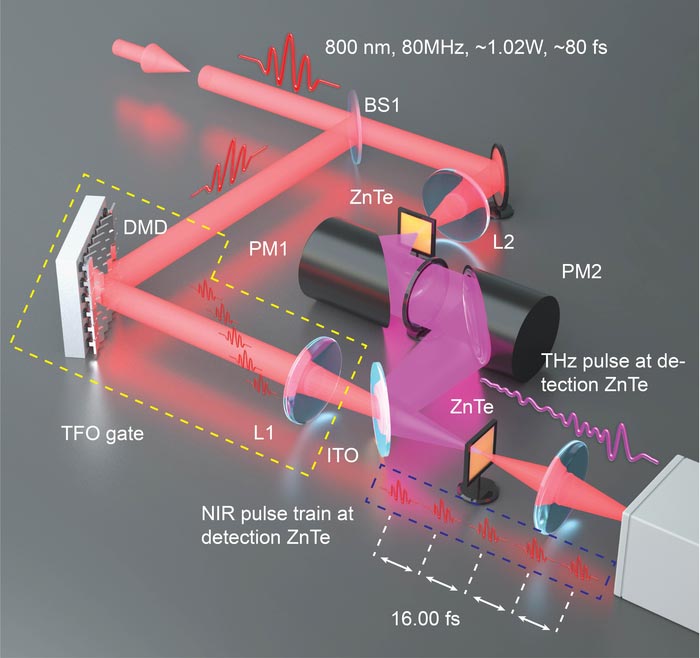

Schematics of the experimental setup showing a temporal fan out (TFO) gate represented by the yellow dashed box, which includes a digital micromirror device. The propagation direction of prepared input ultrafast pulse, originating in blue dashed box, is shown in pink. Dark red lines represent the corresponding pulse front.
Illustration by Jiapeng Zhao
Rochester researchers next will aim for a combination of spatial, temporal imaging.
When we look at an object with our eyes, or with a camera, we can automatically gather enough pixels of light at visible wavelengths to have a clear image of what we see.
However, to visualize a quantum object or phenomenon where the illumination is weak, or emanating from nonvisible infrared or far infrared wavelengths, scientists need far more sensitive tools. For example, they have developed single-pixel imaging in the spatial domain as a way to pack and spatially structure as many photons as possible onto a single pixel detector and then create an image using computational algorithms.
Similarly, in the time domain, when an unknown ultrafast signal is either weak, or in the infrared or far infrared wavelengths, the ability of single-pixel imaging to visualize it is reduced. Based on the spatio-temporal duality of light pulses, University of Rochester researchers have developed a time-domain single-pixel imaging technique, described in Optica, that solves this problem, detecting 5 femtojoule ultrafast light pulses with a temporal sampling size down to 16 femtoseconds. This time-domain analogy of the single-pixel imaging shows similar advantages to its spatial counterparts: a good measurement efficiency, a high sensitivity, robustness against temporal distortions and the compatibility at multiple wavelengths.
Lead author Jiapeng Zhao, a PhD student in optics at the University of Rochester, says possible applications include a highly accurate spectrographic tool, demonstrated to achieve 97.5 percent accuracy in identifying samples using a convolutional neural network with this technique.
The technique can also be combined with single-pixel imaging to create a computational hyperspectral imaging system, says Zhao, who works in the Rochester research group of Robert Boyd, professor of optics. The system can greatly speed up the detection and analysis of images at broad frequency bands. This could be especially useful for medical applications, where detection of nonvisible light emanating from human tissue at different wavelengths can indicate disorders such as high blood pressure.
“By coupling our technique with single pixel imaging in the spatial domain, we can have good hyperspectral image within a few seconds. That’s much faster than what people have done before,” Zhao says.
Other coauthors include Boyd and Xi-Cheng Zhang at Rochester, Jianming Dai at Tianjin University, and Boris Braverman at the University of Ottawa.
This project was supported with funding from the Office of Naval Research, the National Natural Science Foundation of China and the National Key Research and Development Program of China.
Journal: Optica
DOI: https://doi.org/10.1364/OPTICA.431455
Method of Research: Experimental study
Subject of Research: Not applicable
Article Title: Compressive ultrafast pulse measurement via time-domain single-pixel imaging
Article Publication Date: 30-Aug-2021
Media Contact
Robert Marcotte
University of Rochester
bmarcotte@ur.rochester.edu
Office: 585-329-3583












